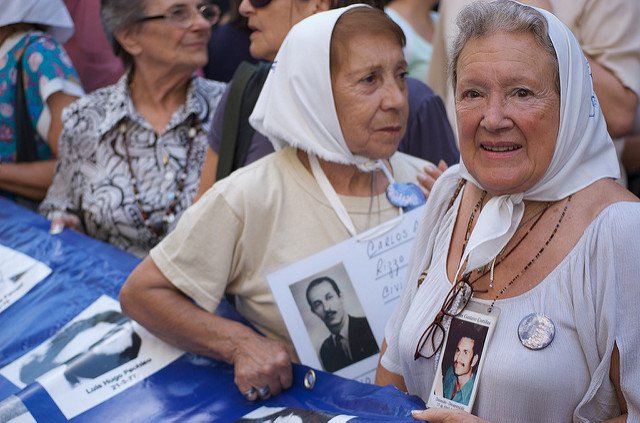They are the two most emblematic human rights organizations in Argentina that were born after the 1976 coup d’état and the establishment of the military dictatorship headed by Jorge Videla and Emilio Massera, among others.
Argentine human rights organizations and emblems of the fight against state terrorism (1976-1983)
The group of mothers first met in 1977 in the Plaza de Mayo to demand a meeting with the ruling military commander and to obtain information about their illegally detained and disappeared children.
Later, and following the cruel advance of the dictatorial regime, they began to fight for the recovery of their children, the prosecution, and sentencing for crimes against humanity of all the military personnel responsible for the crimes against humanity perpetrated against them.
The white scarves on their heads and the weekly march on Thursdays around the Plaza de Mayo were and are their distinctive features and have acquired the status of symbols.
The military regime known as the National Reorganization Process is said to have caused the disappearance of some nine thousand people according to statistics verified by CONADEP (National Commission for the Disappeared), however, for many this figure is small and they speak of the possibility of some thirty thousand.
Mothers on the march who gave their lives for their children
Although the dictatorship began to persecute them, when their demonstrations became increasingly multitudinous and noisy, and many of them even disappeared like their children, they never gave up on their goals and to this day continue to fight to obtain justice and to find out the final fate of their relatives.
The Madres group was divided into two internal currents: on the one hand, the group led by Hebe de Bonafini, and on the other, the founding line headed by Marta Vásquez.
Bonafini is without a doubt the most popular member of the mothers, but also the most controversial due to her extreme political positions and her hyper-violent statements towards some political leaders with whom she does not agree.
Grandmothers and their endless search to restore the missing grandchildren
The grandmothers, for their part, emerged later and focused on the claim for their missing relatives, but also for their grandchildren, whom they did not know because their daughters-in-law or daughters were detained during their pregnancy and held captive.
A huge number of women gave birth to their children in clandestine detention and extermination centres, where they were not only held illegally but also tortured.
The grandmothers’ organization has developed an effective research method and thanks to it they have managed to return 128 grandchildren who disappeared during the dictatorship, who were illegally handed over to adoptive families, and who for the most part were unaware of their origins.
DNA testing was and is crucial in identifying the alleged grandchildren.
The organization has various very discreet means of contact through which questions can be made if someone has doubts about its identity.
In 2014, and with number 114, the grandson of the most emblematic member was reinstated: Ignacio Montoya Carlotto, grandson of Estela Carlotto.
Following the restoration of democracy and in the years that followed, both groups played a crucial role in identifying victims and survivors of the dictatorship, as well as in seeking justice, punishment, and compensation for survivors and bereaved relatives.
A political approach that distanced them from popular consideration
In 2003, with the assumption of Néstor Kirchner as president and then during the two presidencies of his wife Cristina Fernández, both associations enjoyed unprecedented relevance, being granted public funds to finance their activities and projects, such as the radio, the university, and the housing construction plan managed by the mothers with Bonafini at the head.
The construction project was suspended amid a scandal over corruption allegations.
The end of the Kirchner government meant the end of many privileges enjoyed by these institutions, and this, combined with the change of political sign, opened a strong dispute and a tense relationship with the government of Mauricio Macri, especially on the part of Bonafini, who has attacked Macri and his family with violent epithets.
In the former ESMA (Navy Mechanics School), which was one of the main clandestine detention centres, there is now a space dedicated to the memory of all those who disappeared during the dictatorship, which is managed by both groups, and whose main aim is to Not Forget and to continue raising the flag of justice.
Although the aforementioned associations have enjoyed local and international recognition and respect since their creation, it cannot be overlooked that during the years of the Kirchnerism government, they enjoyed many privileges, which led them to align themselves politically with the movement, but they certainly lost the autonomy and respect that had distinguished them in the past.
Many Argentines today criticize her activities, especially those of the Mothers, for the bad image that Hebe de Bonafini has garnered in recent years, entangled in cases of corruption and money laundering, and for her very controversial, xenophobic, and violent statements.
